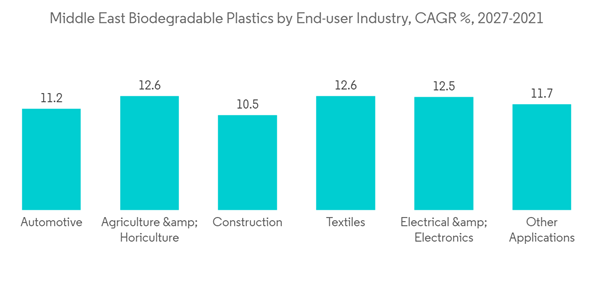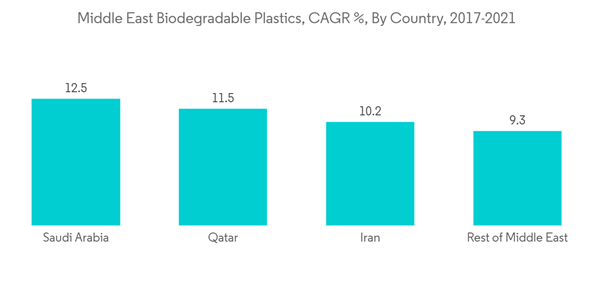Key Highlights
- A major factor driving the market studied is the environmental issues encouraging an alternative to single-use plastic and promoting bioplastics. Additionally, the growing demand for packaging is likely to affect the market’s growth.
- However, the availability of cheaper alternatives is likely to hamper the market’s growth.
Recent research in biodegradable products led to a product that is easily soluble in water in under three days. New products with the shortest time to degrade after disposal will provide market growth opportunities.
Middle East Biodegradable Plastics Market Trends
Soaring Demand from the Packaging Industry
- The largest consumer of biodegradable plastics is packaging; packaging industries began to replace regular plastic with biodegradable plastic, supporting government incentives for sustainability.Biodegradable plastics are used in flexible and rigid packaging applications. They are used to package organic food as well as premium and branded products.
- Middle Eastern governments' intervention in banning single-use plastic and promoting incentives for alternatives amplified the biodegradable plastic market's growth. For instance, according to a poll conducted in January 2022 by the Government of Dubai, 85% of the Emirate population supports the ban on plastic bags.
- The Gulf countries are rushing to promote eco-friendly lifestyles.As part of a more comprehensive goal to reduce plastic consumption, Abu Dhabi has already banned single-use plastic bags. The United Arab Emirates, which will host the COP28 meeting in 2023, has also released a Circular Economy Policy that promises to assist businesses in adopting environmentally friendly production practices. Moreover, Saudi Arabia recently pledged to achieve net-zero emissions by 2060.
- The biodegradable packaging segment is driven by changing consumer behaviors and the rising preference for convenience foods, which necessitate the use of special types of packaging. People prefer fresh food that is packaged in a way that is good for the environment. This has an effect on the Middle Eastern market for biodegradable food packaging products.
- Starch-based biodegradable plastics are increasingly used in the packaging industry. Some starch-plastic products are easily soluble in water, making them an attractive eco-friendly alternative to single-use plastics.
- So, we expect that the above-mentioned factors will have a positive effect on the market over the next few years.
United Arab Emirates to Dominate the Market
- UAE is one of the most prominent economies in the Middle East. As reported by the International Monetary Fund (IMF), the country recorded its GDP at USD 409.97 billion in 2021.
- In 2021, the country registered a GDP growth of 2.3%, indicating recovery after a decline of -6.1% recorded in 2020 due to the COVID-19 pandemic, which affected economic activities in the country. UAE is expected to record 4.2% year-on-year growth during 2022, as published by reports from IMF.
- UAE announced a complete ban on single-use plastic bags and materials and to promote biodegradable plastic in Sharjah, hence, shops in the UAE are expected to start imposing a tariff from October 1, 2022, on each single-use plastic bag presented to the consumer.
- UAE food and beverage manufacturer Agthia launched a biodegradable water bottle, biomaterials like cornstarch and fermented sugarcane were used in the production.
- Biodegradable plastics made of cornstarch have applications in flexible and loose-fill packaging. UAE startup MYEARTH from Ecoway Biopolymers LLC launched cornstarch products like shopping bags, garbage bags, landscaping sheets, straws, and boxes. UAE food packaging and grocery chains started to replace regular plastic with cornstarch plastics, boosting the biodegradable plastic demand in the region.
- Moreover, Hotpack Global, the UAE-based leading food packaging manufacturer, opened an exclusive Retail Showroom in Riyadh on August 31, 2022. The store has exclusive shelves for biodegradable products, in line with Hotpack’s commitment to sustainability. Biodegradable plastic films like bio polyethylene terephthalate (PET), bio polyethylene, and bio polypropylene are majorly used as packaging films.
- Hence, the market scenario in the region is expected to boost biodegradable plastics demand throughout the forecast period.
Middle East Biodegradable Plastics Market Competitor Analysis
The Middle East biodegradable plastics market is partially consolidated in nature. Some of the major players in the market include Avani Eco, Al Bayader International, Al-Habib Polymers, BASF SE, Cargill Incorporated, Ecoway Biopolymers LLC, EcoPlast Solutions, Eastman Chemical Company, Green Packaging Industries, KiSabz (Maadiran), and Plastcom Middle East FZCAdditional benefits of purchasing the report:
- The market estimate (ME) sheet in Excel format
- 3 months of analyst support
This product will be delivered within 2 business days.
Table of Contents
1 INTRODUCTION1.1 Study Assumptions
1.2 Scope of the Study
2 RESEARCH METHODOLOGY
3 EXECUTIVE SUMMARY
4 MARKET DYNAMICS
4.1 Drivers
4.1.1 Environmental Factors Encouraging a Paradigm Shift
4.1.2 Growing Demand for Bioplastics in Packaging
4.2 Restraints
4.2.1 Availability of Cheaper Alternatives
4.2.2 Other Restraints
4.3 Porter's Five Forces Analysis
4.3.1 Bargaining Power of Suppliers
4.3.2 Bargaining Power of Buyers
4.3.3 Threat of New Entrants
4.3.4 Threat of Substitute Products and Services
4.3.5 Degree of Competition
5 MARKET SEGMENTATION
5.1 Type
5.1.1 Strach based
5.1.2 Polylactic Acid (PLA)
5.1.3 Other Types
5.2 Application
5.2.1 Packaging
5.2.2 Other Applications
5.3 Geography
5.3.1 United Arab Emirates
5.3.2 Saudi Arabia
5.3.3 Qatar
5.3.4 Iran
5.3.5 Rest of Middle East
6 COMPETITIVE LANDSCAPE
6.1 Mergers and Acquisitions, Joint Ventures, Collaborations, and Agreements
6.2 Market Share (%)**/Ranking Analysis
6.3 Strategies Adopted by Leading Players
6.4 Company Profiles
6.4.1 Avani Eco
6.4.2 Al Bayader International
6.4.3 Al-Habib Polymers
6.4.4 BASF SE
6.4.5 Cargill Incorporated
6.4.6 Eastman Chemical Company
6.4.7 Ecoway Biopolymers LLC
6.4.8 EcoPlast Solutions
6.4.9 Green Packaging Industries
6.4.10 KiSabz (Maadiran)
6.4.11 Plastcom Middle East FZC
7 MARKET OPPORTUNITIES AND FUTURE TRENDS
7.1 Growing Use in the Electronics Industry
Companies Mentioned (Partial List)
A selection of companies mentioned in this report includes, but is not limited to:
- Avani Eco
- Al Bayader International,
- Al-Habib Polymers
- BASF SE
- Cargill Incorporated
- Eastman Chemical Company
- Ecoway Biopolymers LLC
- EcoPlast Solutions
- Green Packaging Industries
- KiSabz (Maadiran)
- Plastcom Middle East FZC
Methodology

LOADING...










